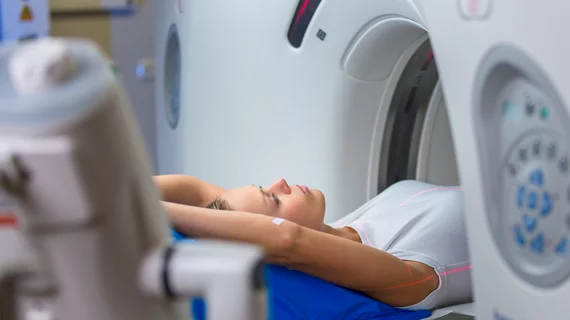Radiology providers continue using computed tomography as a key tool to diagnose the new coronavirus, despite a growing group of experts lining up against this practice.
It’s been about one month since the American College of Radiology first declared that clinicians should not use CT as a front line tool to detect the virus. Clinicians continue to deploy the modality as a central piece of their COVID game plan, particularly those who lack access to scarce testing kits, Bloomberg reported Thursday.
“The problem is, in a lot of small community hospitals, we’re waiting up to 12 days [for a test to come back]. And at that point, a test that’s essentially not available is worthless,” Daniel Ortiz, MD, a radiologist in rural Georgia, told the publication. “The more resource-constrained hospitals are having a lot more of a discussion about this than ones that have access to rapid testing. That’s a big distinction,” he added later.
ACR’s March 11 guidance cited a lack of specificity and infection control challenges as reasons to avoid CT as the first line of diagnosis. The Bloomberg report also noted price as a major concern. Chest scans can cost hundreds to thousands of dollars, while Medicare pays up to $51 for a COVID-19 lab test—though private payers typically reimburse more.
Numerous studies out of China have touted CT’s valuable role in diagnosis, while others have lined up on the side of skepticism. The Royal College of Radiology last month asserted that “there is no current role for CT in the diagnostic assessment of patients with suspected coronavirus infection.” On April 8, three radiologists further explored concerns about the modality’s role in addressing the pandemic.
The team of imaging scientists reviewed several studies out of China and elsewhere and found “many problems,” they wrote in Annals of Internal Medicine. Those included faulty research design, incomplete “methods” sections, and multiple confounding variables.
“Although the intention of the literature promoting the use of CT for the diagnosis of COVID-19 is admirable—that is, faster diagnosis—it has caused confusion within the radiology community,” wrote Michael Hope, MD, with the University of California, San Francisco, and colleagues. “One of the repercussions of using CT in the diagnosis of COVID-19, which is not discussed in the radiology literature, is that safely performing imaging is problematic. At the very least, droplet precautions with appropriate protective gear (now in short supply) need to be followed, CT scan rooms must be thoroughly cleaned, and the air needs to be recirculated given that COVID-19 is an airborne disease. Even if all protocols are followed, there is a risk that COVID-19 infection may be passed to other patients or staff in imaging departments.”
You can read the entire Annals of Internal Medicine piece for free here, and check out the Bloomberg story below:

